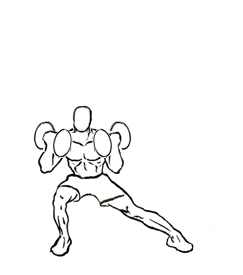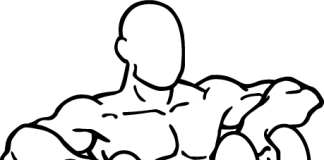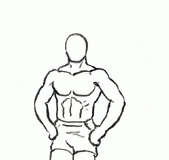Last Updated on September 26, 2014
Combining exercises not only challenges your muscles but also your coordination and stability, enhancing overall body control. One such advanced exercise is the Lateral Lunge with Bicep Curl using Dumbbells. It’s a dynamic move that targets your lower body, upper body, and core simultaneously, making it an efficient and effective workout. In this post, we’ll explore how to perform this exercise correctly, its benefits, common mistakes to avoid, and ways to modify or progress this exercise to suit your fitness level.
Benefits of the Lateral Lunge with Bicep Curl using Dumbbells
Before diving into the steps, it’s essential to understand why this exercise is a valuable addition to your routine:
- Targets Multiple Muscle Groups:
- The lateral lunge focuses on the quads, hamstrings, glutes, and inner thighs, providing a comprehensive lower-body workout.
- The bicep curl works your upper arms, specifically the biceps, helping to build strength and definition.
- Engaging the core for balance and stability during the movement improves core strength and posture.
- Improves Balance and Coordination:
- Combining lower and upper body movements challenges your stability, enhancing balance and coordination.
- This functional movement is similar to actions we perform daily, such as reaching sideways or lifting objects while bending.
- Enhances Flexibility and Mobility:
- The lateral lunge involves a significant range of motion, helping to stretch and strengthen the hip muscles.
- It’s an excellent way to open up the hips and improve flexibility, especially for those who sit for long periods.
- Promotes Cardiovascular Health:
- Incorporating this compound movement into high-intensity interval training (HIIT) or circuit workouts can increase your heart rate, providing cardiovascular benefits while building strength.
How to Perform the Lateral Lunge with Bicep Curl using Dumbbells
Setup:
- Equipment Needed: A pair of dumbbells, preferably light to moderate weight depending on your fitness level.
- Starting Position:
- Stand upright with your feet together, back straight, and abs engaged.
- Hold a dumbbell in each hand, allowing your arms to hang down with palms facing up (supine position) in front of your thighs.
Steps:
- Prepare for the Lunge:
- Begin by keeping your back straight, chest lifted, and core tight.
- Engage your glutes and quads for stability as you prepare for the lunge.
- Lateral Movement:
- Take a big step sideways with your right foot. As your foot lands, bend your right knee while keeping your left leg straight.
- Lower your hips back and down into a squat position, ensuring your right knee does not extend beyond your toes.
- Your left leg remains straight, and your toes should point forward.
- Incorporate the Bicep Curl:
- As you lower into the lunge, curl the dumbbells toward your shoulders, contracting your biceps.
- Keep your elbows close to your body and focus on squeezing the biceps at the top of the curl.
- Return to Starting Position:
- Push off your right foot and bring your feet back together, straightening your legs as you lower the dumbbells back to the starting position.
- Make sure to maintain a controlled movement as you return to standing.
- Repeat on the Opposite Side:
- Step sideways with your left foot, bending the left knee while keeping the right leg straight. Perform the bicep curl simultaneously.
- Alternate sides for the desired number of repetitions.
Common Mistakes to Avoid
Even advanced exercisers can make mistakes that reduce the effectiveness of the movement or increase the risk of injury. Here are some common errors to watch out for:
- Letting the Knee Extend Beyond the Toes:
- When lunging, make sure the lunging knee stays aligned with your ankle to protect your joints and avoid unnecessary strain.
- Rounding the Back:
- It’s crucial to maintain a neutral spine throughout the exercise. Rounding your back can put pressure on your lower spine and reduce core engagement.
- Focus on keeping your chest lifted and your core tight to prevent this.
- Swinging the Weights:
- The bicep curl should be controlled, with no momentum used to lift the weights. Swinging the dumbbells not only reduces muscle activation but also increases the risk of injury.
- Perform the curl slowly and focus on squeezing the biceps.
- Not Engaging the Core:
- Failing to engage the core can lead to instability and poor posture, compromising the effectiveness of the exercise.
- Tighten your abs throughout the movement to enhance stability and protect your back.
Modifications for Different Fitness Levels
The Lateral Lunge with Bicep Curl is an advanced exercise, but it can be adjusted to suit different fitness levels:
Beginners:
- Bodyweight Only: If you’re new to this movement, start without weights. Focus on mastering the lunge form before incorporating the bicep curl.
- Assisted Lunge: Hold onto a stable surface like a wall or chair for balance while performing the lateral lunge.
- Light Weights: Use lighter weights until you feel confident in your balance and form.
Intermediate:
- Increase Reps and Sets: Gradually add more repetitions and sets as your strength and endurance improve.
- Slow Down the Movement: Performing the lunge and curl slowly increases time under tension, promoting muscle growth and endurance.
- Add a Pause: Pause at the bottom of the lunge for 2-3 seconds before pushing back to the starting position. This enhances muscle engagement and improves stability.
Advanced:
- Increase Weight: Use heavier dumbbells to add intensity, challenging your strength and coordination further.
- Single Dumbbell Curl: Hold one heavier dumbbell with both hands for the bicep curl, making the movement more challenging.
- Combine with Other Exercises: Integrate this exercise into a circuit or superset it with other compound movements like push-ups or squats for a full-body workout.
Variations of the Lateral Lunge with Bicep Curl using Dumbbells
- Lateral Lunge with Hammer Curl:
- Instead of a traditional bicep curl, perform a hammer curl where your palms face each other. This variation targets the brachialis, the muscle beneath the biceps, providing additional arm definition.
- Alternating Lateral Lunge with Overhead Press:
- Add an overhead press instead of a bicep curl after lunging to target the shoulders and triceps. This version also challenges your balance and core strength further.
- Weighted Vest Variation:
- If you want to increase intensity without adding dumbbell weight, consider using a weighted vest. This keeps the weight evenly distributed, allowing you to focus on your form during the lunge and curl.
Incorporating the Lateral Lunge with Bicep Curl using Dumbbells into Your Workout Routine
This compound movement can be an excellent addition to various types of workouts:
- Strength Training: Include it as part of your upper/lower body split routine or a full-body workout.
- HIIT Workouts: Incorporate the lateral lunge with bicep curl into a high-intensity interval training (HIIT) circuit to boost your heart rate while building muscle.
- Warm-Up/Activation: Use lighter weights or bodyweight variations during your warm-up to activate the lower body and upper arms before lifting heavier weights.
Recommended Sets and Reps
- For beginners: 3 sets of 8-10 reps (per side) with light or no weights.
- For intermediates: 4 sets of 10-12 reps (per side) with moderate weights.
- For advanced: 4 sets of 12-15 reps (per side) with heavier weights, incorporating pauses or slower tempos for added challenge.
Safety Tips
To prevent injury and ensure you get the most out of the exercise, follow these safety guidelines:
- Warm Up Properly:
- A good warm-up should include dynamic stretches and mobility drills to prepare your muscles, especially the hips and shoulders.
- Perform movements like leg swings, hip circles, and light arm stretches before diving into the lateral lunge.
- Listen to Your Body:
- If you feel any pain or discomfort in your knees, hips, or back, stop and reassess your form. Make adjustments or lighten the load if necessary.
- Progress Gradually:
- Don’t rush into using heavy weights or increasing intensity. Master the basic movement before progressing to advanced variations or adding additional weight.
Final Thoughts
The Lateral Lunge with Bicep Curl using Dumbbells is a versatile and effective exercise that can take your strength and coordination to the next level. By combining a lower body movement with an upper body lift, you engage multiple muscle groups, improve balance, and enhance overall fitness. Whether you’re a beginner or an advanced fitness enthusiast, this movement offers plenty of ways to progress and challenge yourself. Remember to focus on form, adjust the weight as needed, and listen to your body for the best results.Note: Have a Personal Trainer or Instructor show you how to properly perform this exercise.








